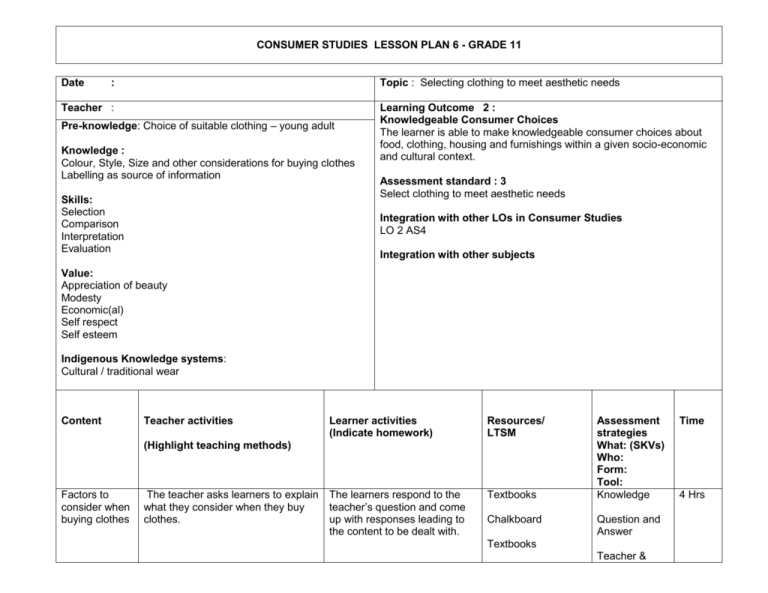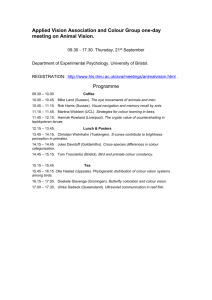Selecting clothing to meet aesthetic needs
advertisement

CONSUMER STUDIES LESSON PLAN 6 - GRADE 11 Date : Topic : Selecting clothing to meet aesthetic needs Teacher : Pre-knowledge: Choice of suitable clothing – young adult Knowledge : Colour, Style, Size and other considerations for buying clothes Labelling as source of information Skills: Selection Comparison Interpretation Evaluation Learning Outcome 2 : Knowledgeable Consumer Choices The learner is able to make knowledgeable consumer choices about food, clothing, housing and furnishings within a given socio-economic and cultural context. Assessment standard : 3 Select clothing to meet aesthetic needs Integration with other LOs in Consumer Studies LO 2 AS4 Integration with other subjects Value: Appreciation of beauty Modesty Economic(al) Self respect Self esteem Indigenous Knowledge systems: Cultural / traditional wear Content Teacher activities Learner activities (Indicate homework) Resources/ LTSM (Highlight teaching methods) Factors to consider when buying clothes The teacher asks learners to explain The learners respond to the what they consider when they buy teacher’s question and come clothes. up with responses leading to the content to be dealt with. Textbooks Chalkboard Assessment strategies What: (SKVs) Who: Form: Tool: Knowledge Question and Answer Textbooks Teacher & Time 4 Hrs 1. Displays a collection of pictures showing the following : - Assorted colours - Varied clothing styles - Different figures and Fabric and clothing items; Accessories; Allows learners to interact with what is on display and discuss as pairs how these various items influence clothing choices Randomly selects learners to report about their discussion; Refers to these and expatiates on learners’ responses indicating how they influence choice of clothing, giving a summary. Colour in selecting clothes 2. Explains aspects of colour i. e. properties, classification and characteristics of colour; The Colour wheel Introduces learners to the colour wheel explaining the three classes from which it is made; With the aid of the items on display (used earlier), the teacher asks learners to create own colour combinations from displayed items/ using pencils and paints (if colour of preference is not available, they may only use the hue); Samples learners to present the preferred colour combinations and as this is done the teacher classifies the particular combinations. Allocates the following to different groups of learners: - Personality Age Colour type - Figure - Season Colour combinations Factors influencing choice of colour Observe and handle items on display, discussing as pairs; Report as expected Magazines Peer Collection of clothing-related items Question and answer Clothing publications and magazines Discussion Peer Oral presentation Chalkboard Listening and note taking Colour wheel Create own colour combinations Teacher & Peers Items on display Colour pencils/ Water paints Present their colour choices with motivation Templates of figures Colour combinations noted Group discussion Group discussion - Texture of fabric, then Have each group discuss how they Report back think each factor influences choice of colour. The teacher consolidates the learners’ presentations in the form of a summary. Tells them to develop own colour Develop colour wheels wheels (as homework). Labeling as a Shows an enlarged version of an The learners observe labels source of information label on the chalkboard written on their uniforms to information and then interprets it for the learners, give meaning to what the emphasizing such aspects as : teacher is explaining. - Symbols used and their meaning; - Relationship between fibre content and care instructions - Order in which the care labels are in; - Direction faced by certain symbols, then Distributes a range of labels Interpret the information collected from learnerswritten on labels - Asks them to work as pairs; - Write the information thereon; - Interpret the information thereon; - Present to the entire class Gives chalkboard summary based on presentations made. Expanded opportunities: Further reading in various other textbooks. Presentation Homework Information labels Skill Chalkboard Reflection: Date completed: …………………… Teacher’s Signature: ………………………. HOD’s Signature: ………………….. Date: …………….. Teacher & Peer






